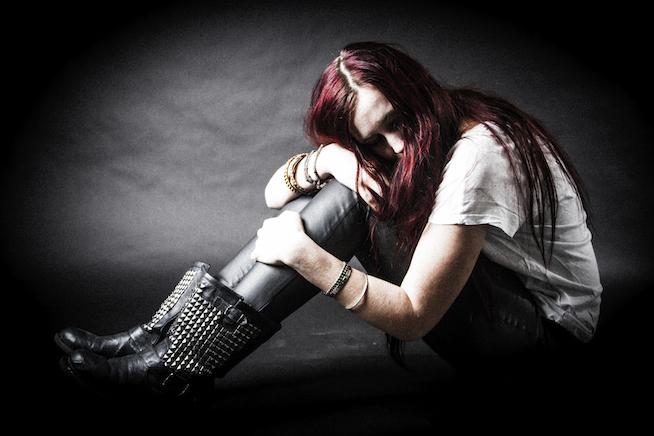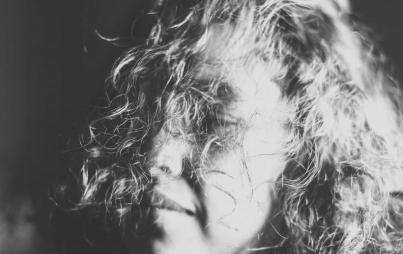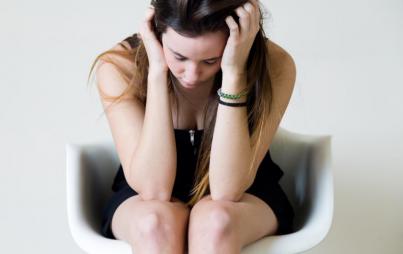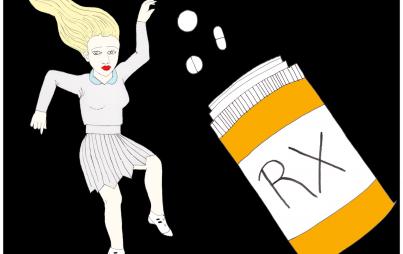
Recovery is an ongoing process.
I slowly began to eat, which, to my immense relief, aided my sleep. I learned depriving my body of essential nutrients had only exacerbated my insomnia.
“Are you a cutter?” the medical aide asked me, gearing to strap a blood-pressure monitor around my upper arm to take my vitals at 11 o’clock one evening. I had entered the psychiatric unit, or as it was officially designated, behavioral health center.
I don’t recall if I indicated affirmatively using my verbal synapses, or by the 15 visibly self-inflicted bread knife lacerations that decorated 3/4 of my forearm like crude lines of poetry.
The aide continued, “You’re too pretty; you got to find something else.”
Hours before, I ingested the remainder of the clonazepam — the generic form of Klonopin, a benzodiazepine — pills I kept in a metal cylinder attached to my key ring. Roughly six times my prescribed dosage of midday anti-anxiety meds.
Recognizing a destructive behavioral pattern, as I had set a precedent of self-medication with prescription drugs and alcohol, I called a hotline, whose operator instructed me to go to the nearest emergency room.
I was transported by ambulance, fully lucid and chatting amicably with the EMT, to a mental hospital one county over.
"This facility is under surveillance," read the insignias posted throughout the ward.
Jacob, another patient on the unit, asked me what I was “in” for: depression, anxiety, self-harm, self-medication.
“You’ll learn everybody’s stories in here,” he replied.
Upon my arrival, the cuts and burns I’d inflicted upon my flesh a month before were inspected (and documented, I presumed) in a partitioned, fluorescently-lit room.
“Why do you guys do that?” a hospital employee questioned condescendingly when I revealed the self-harm scars on the soles of my feet.
I was led to a room complete with a roommate — a grandmother who had entered the facility for “drinking too much alcohol,” she told me — and was administered trazodone, an anti-anxiety pill often used as a sleep aid.
The following morning, we were awoken early so the nurses could take vitals. At 8 a.m., all the patients lined up behind locked doors, waiting for supervisors to accompany us to the cafeteria for breakfast.
Our plastic forks, knives, and spoons were counted upon leaving the cafeteria, but that morning, my knife inexplicably disappeared.
“You took the knife to cut, didn’t you?” a 20-something grinned jokingly (I hadn’t). The supervisor on duty eyed me skeptically as I fumblingly explained my knife was missing, but she allowed me to exit.
On the first day, I attended “groups:” gatherings of patients and therapists to participate in various activities — art, meditation, and talk therapy among them. We were instructed to write a single, achievable goal on a piece of paper every morning and evaluate our efforts at the end of the day.
Though I entered voluntarily, I couldn’t leave of my own free will. I was fixed in the facility until a doctor deemed me fit to exit and signed off on my discharge.
By day two, I was anxious that I still hadn’t been granted the opportunity to speak with a doctor. Ergo, I was unsure of when I was going to be able to leave.
I spent the day curled on my cot, skipping meals and group sessions, crying softly. I don’t belong here. Get me out. Food was brought to me in disposable containers and placed on my bedside table.
Finally, in the late afternoon, a doctor arrived and explained when I’d be able to leave: three-and-a-half days after my initial admittance.
The nurses transitioned me off Klonopin and onto the antihistamine Vistaril, (to which I developed a quasi-drunken reaction days later after I was released from the hospital) as I had ceased to take in favor the next in line of a myriad of psychotropics.
One evening, a football game was being broadcast on the TV in one of the communal meeting areas. I opted to read the book I’d brought — Christopher Reeve’s autobiography, Still Me.
“She’s gonna be fine,” the other patients commented, watching me. “Look at her...reading.”
At one point, I crossed the lounge to the refrigerator in a lace-trimmed-black tank top, and a patient catcalled, “Damn, you look good.” Motherfucker, all I wanted was some cranberry juice.
When my parents drove from home (halfway across the state) to see me during visiting hours, I noticed my mom’s wobbly expression on the photo ID that had been dispensed to her and saw, physically, how wounded she’d become by my afflictions.
The following day, my parents brought me back to my hometown, where I stayed for the remainder of autumn and the beginning of winter.
Within three weeks of my discharge, my condition had worsened once more — my appetite and sleep were relatively nonexistent. I lost 10 pounds in a single week, placing my 5’11” frame at 135 pounds. All I wanted, always and desperately, was to sleep.
My brain, lying to me: I won’t eat until I feel better.
My body, depreciating: You won’t feel better until you eat.
Laying in bed apathetically, waiting for the day to end so I could escape from consciousness had become the norm, and waking up a monumental task.
“Does your life seem pretty unbearable right now?” my therapist asked during one counseling session, to which I’d brought my mom. I nodded. Among her recommendations was another voluntary in-patient hospitalization. I was vacillating as to a subsequent course of action.
“This is your life,” said my mom helplessly as we sat in our driveway, after my appointment, as I cried weakly in the passenger seat.
“I don’t know what to do,” I choked out. “I didn’t choose this.”
After a bout of indecisiveness, we jointly decided I was to spend another spell in a different psych ward, this one closer to my parents’ house.
One I arrived, the squeeze of the blood pressure monitor they administered in the hospital mirrored the depression suffocating my mind and viscera — though, unlike my disease, the monitor eventually alleviated its compression. I felt like a sunken, hollow ghost-cadaver of myself.
On the first morning of my week-long stint, it took four professionals to coax me out of bed — I was denied the extra sleep medication I asked for. Across the hall, “creative therapy” was taking place. I refused to participate in the collaging, and instead curled myself tightly in a ball and repressed sobs.
My goal for the first day: Eat one meal. Later, my goal would be to consume all three.
I slowly began to eat, which, to my immense relief, aided my sleep. I learned depriving my body of essential nutrients had only exacerbated my insomnia.
Still, in between groups, I couldn’t help lying on my cot, staring at the ceiling, my mind churning: I was mentally exhausted and profoundly miserable. There was too much noise in my brain for me to function.
I met with a psychiatrist every day, a benefit I wasn’t afforded at the previous institution. She devised a medicinal cocktail based on my specific symptoms; I appreciated her so much that I ended up seeing her on an outpatient basis.
I made friends with patients who had bipolar disorder, schizoaffective disorder, alcoholism, post-traumatic stress disorder, severe chronic depression, suicidal ideations and attempts, heroin addiction, et al.
After a week, I was a new, reformed person, ready to leave the facility and join a “partial hospitalization program” designed to ease the transition from full-on hospitalization to none whatsoever.
After taking a semester off from college to deal with my mental illnesses, I’m now back in school to finish my bachelor’s degree in multimedia journalism. I haven’t self-harmed in months, nor have I handled my issues perfectly — I still struggle to cope in healthy ways, but I am lucky to have supportive relatives and friends.
Recovery is an ongoing process.







